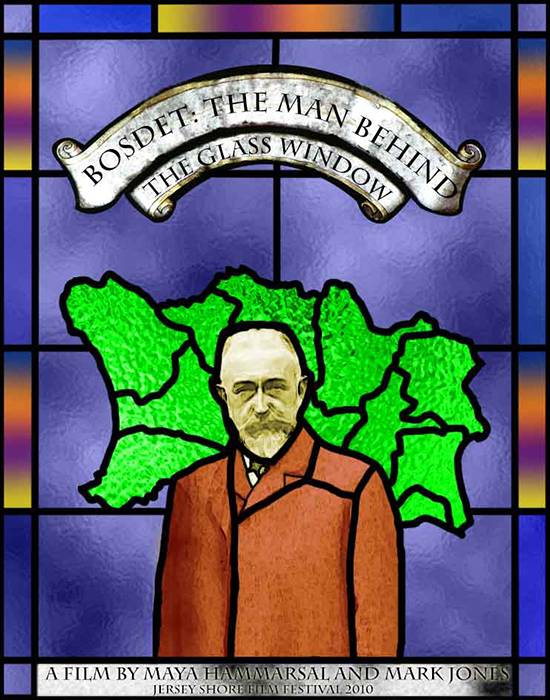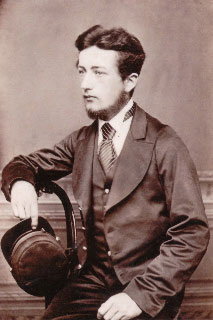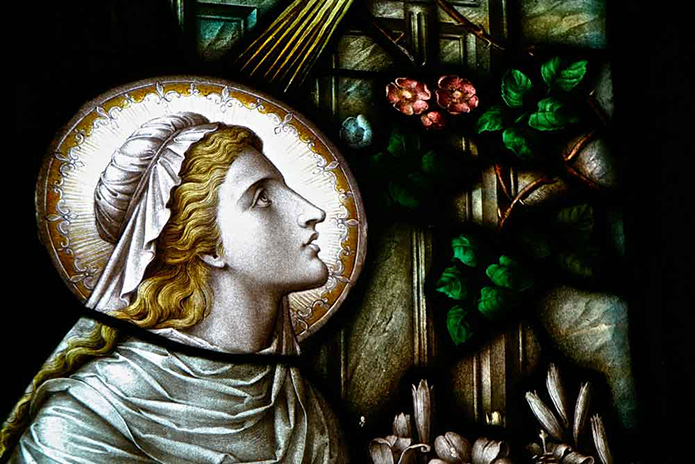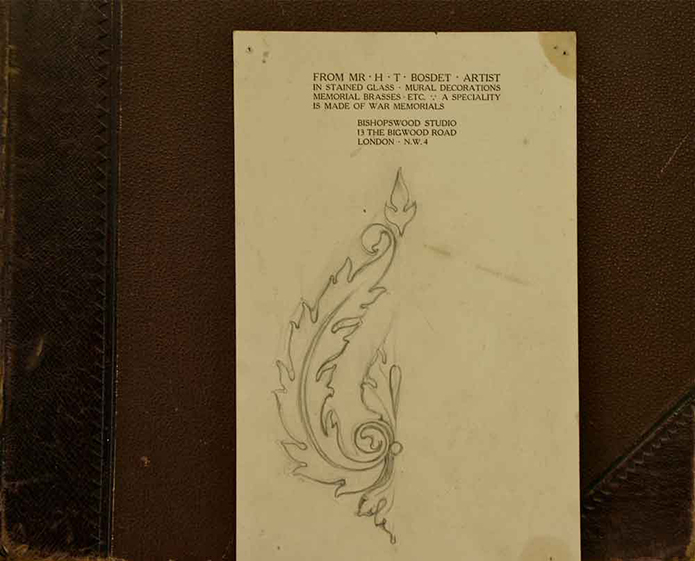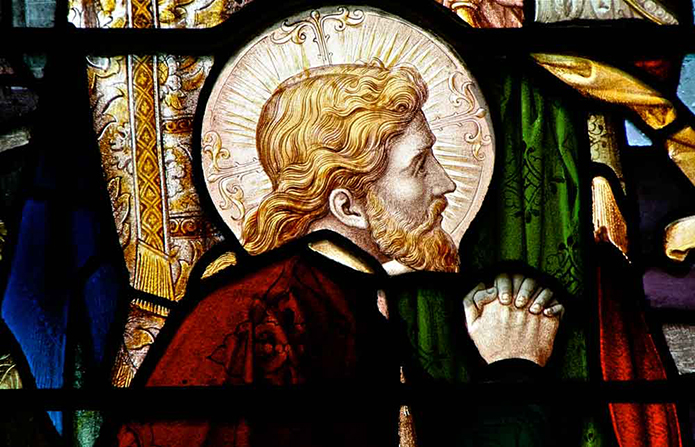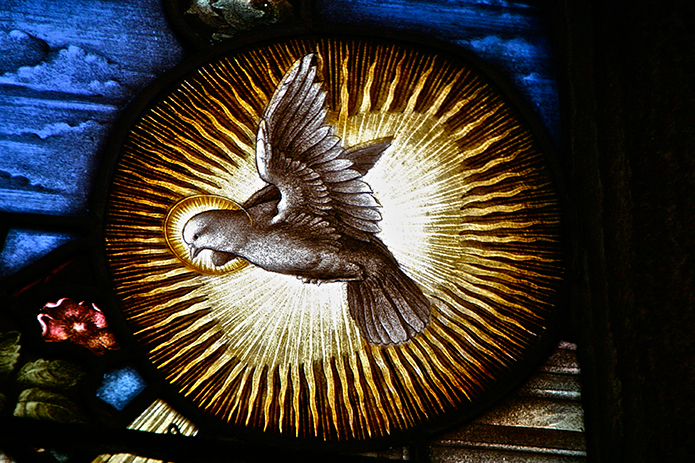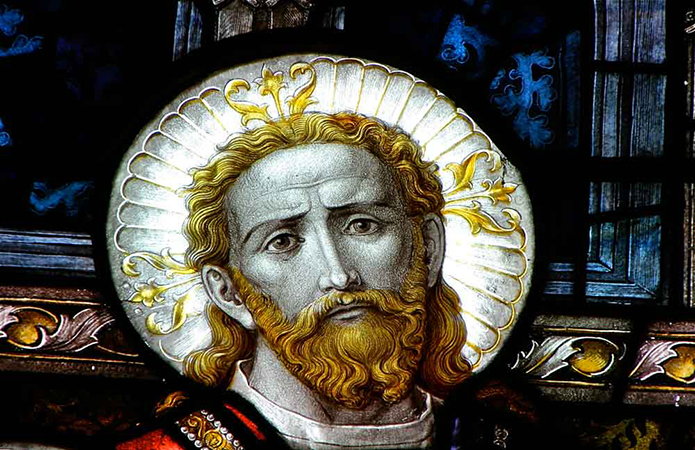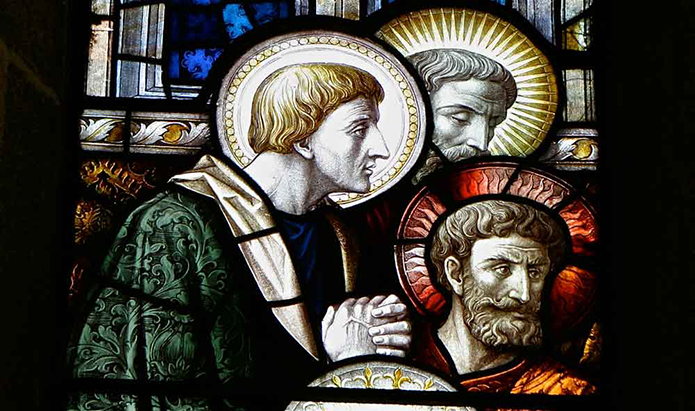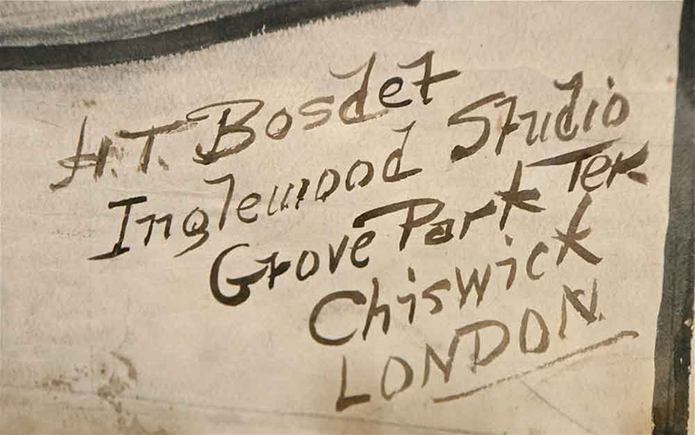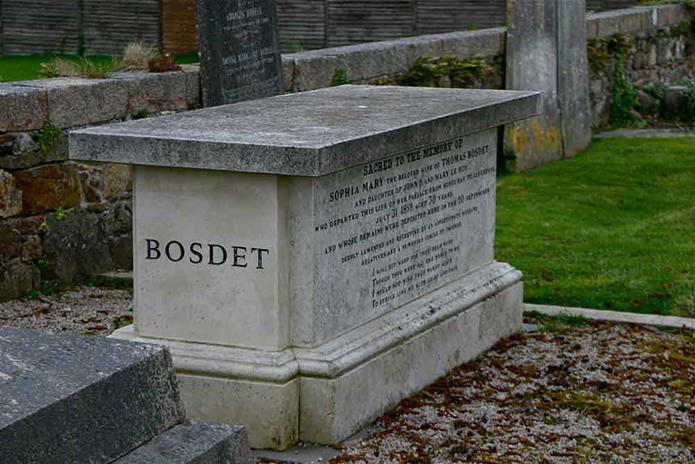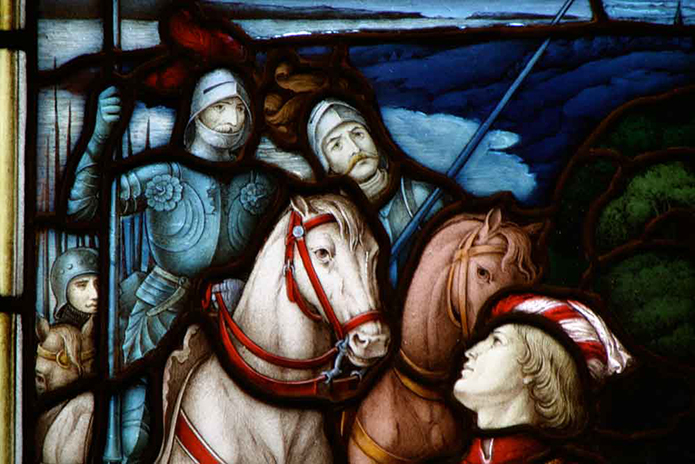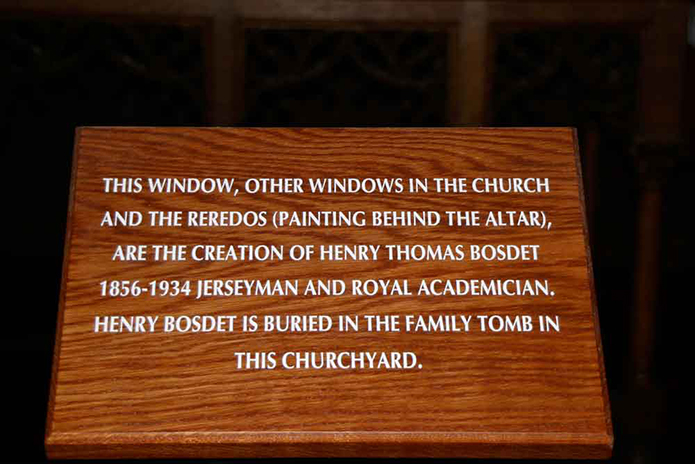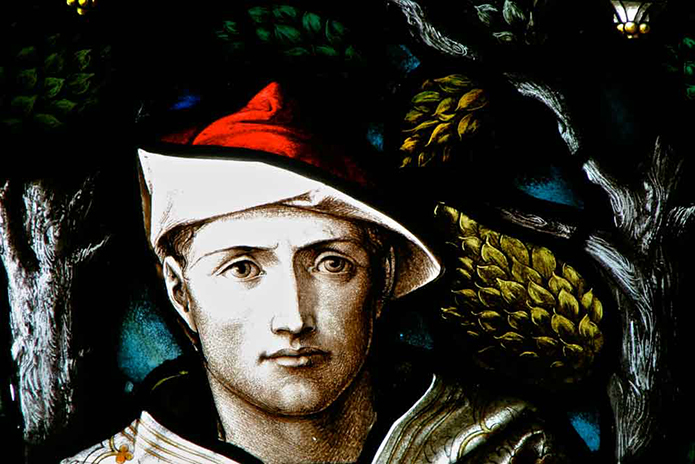
Stained Glass Window at St Brelade Parish Church, Jersey, by Henry Bosdet. Image courtesy of Maya Hammarsal.
After being given The Glass Rainbow – a guide book to the art works of Henri Thomas Bosdet written by Aidan Smith OBE, I visited Jersey churches to view Bodset’s stained glass windows. Regarding this fantastic artwork with fresh eyes, I was intrigued to know more about this enigmatic Jersey man and inspired to make a documentary about his life. Together with Mark Jones, I made the film: Bosdet: The Man Behind the Glass Window.
Facts do exist about Bosdet’s life. Where he lived, family events – births, deaths, marriages, etc., but there are few descriptions of his personality and character. There is only one archived document, written by him, to give insight into the man. In it he defends members of the Jersey Society in London from scurrilous attack. This was a man loyal to his friends and culture. I already loved his work and, as a Jersey woman, it made me proud to see him defend our Island. This man deserved respect for more than his talent.
Uncovering Bosdet, his dreams, drives and desires, proved a stimulating challenge for me during the making of the film. I continually asked myself, who was Henri Thomas Bosdet?
In the end I concluded, it is the work of a man that speaks to whom he was as a person. For me Bosdet was revealed through what he did, and when he achieved it, as indelibly as any eye witness account written in an article.
Bosdet was a Jersey man through to the core. Despite living in London, for most of his life, he maintained strong links with his Island and culture. Most parish churches in Jersey have at least one of his windows indicating frequent travel between his studios in London and the Island.
Born in St Helier, Jersey on 7 January 1856 to a Ships Mariner, Captain Thomas, and his Guernsey wife Sophia Mary neé Le Roy. In common with Islanders of the time Bosdet was trilingual. Jèrriais, the ancient language of William the Conqueror, would have been his mother tongue. In Jersey, at the time, French was used in Church and Court and English for commercial endeavours only.
Bosdet lost his mother when he was three after she contracted typhus fever on a trading voyage to Hondurus, with her husband. Captain Thomas remarried to Emmeline Le Roy, his sister-in-law. The family moved to London when Henri was ten. Bosdet’s Jersey accent (which has a South African air) singled him out as different in a country with strong class distinctions and xenophobic stance.
In his autobiography the artist Will Heath Robinson, one of Bosdet’s later students at the Islington School of Art, described him as, “… A real artist if ever there was one. […] He wore a black velvet coat and an artistic tie. His head was that of a pale young Moses adorned with a long silky beard moustache and waving hair. The finishing touch to this artistic personality was the gold-rimmed monocle with continually dropped from his eye and was replaced as he took a broader or closer view of your drawings. The ladies pronounce his name in the French manner and address him as Mr Bo-day. We, out of perversity and to his annoyance, call him Mr Bozzdett.”
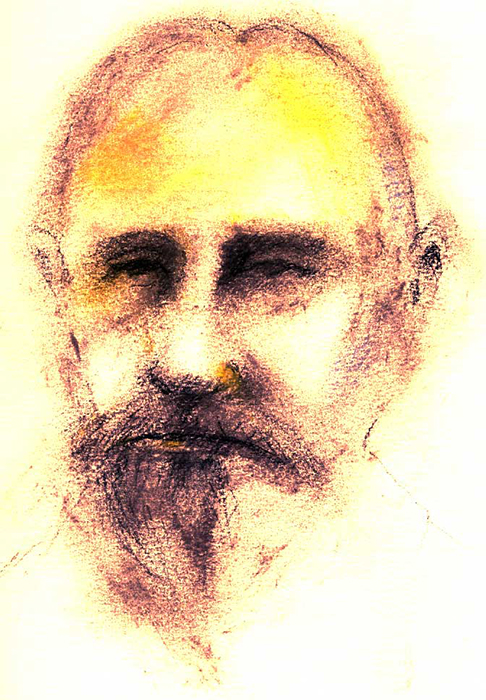
Drawing of Bosdet, aged 60, taken from Société Jersiaise photograph by Steve Walton. Credit: Steve Walton.
This somewhat mocking attitude towards Bosdet’s ‘differences’ perhaps indicates why he was the lowest paid member of staff at the Royal Academy of Art, despite working for them for over fifty years and holding down two curatorships, including Curator of Life School and School of Modelling from Life.
Bosdet’s artistic career began age seventeen. On 10 January 1873 he enrolled as a student at the Royal Academy. Bosdet’s art is heavily influenced by the pre-Raphaelites. He had had the honour of studying under and later working alongside Millais, himself of Jersey descent.
While Bosdet exhibited a portrait at the Royal Academy in 1885. He concentrated more on line work and drawings than painting. His life works were renowned for their perfection with an almost photographic representation of the subject. Today, while his stained glass windows fill Anglican churches and cathedrals around Europe, it is rare to find a painting done by Bosdet. However, Bosdet’s focus away from painting is not due to a lack of talent but rather, I think, a pragmatism that I would recognise as ‘being Jersey.’
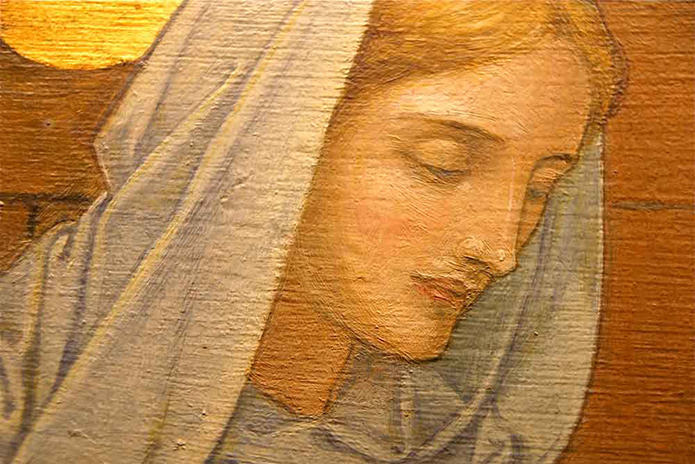
Rare example of Bosdet’s paint work. Mary from Reredos in St Saviour Parish Church, Jersey. Image courtesy of Maya Hammarsal.
In a newspaper article dated around 1882, recounting an inaugural address to students at the Islington School of Art, Bosdet shows that he wasn’t an artist intent on ‘starving for his art.’ He was willing to share, with his colleagues and students, how to balance a drive for producing great artwork with an ability to settle the bills.
“I earnestly recommend that you consider curtains, wallpapers, carpets, engraving and stain glass windows as beautiful. It’s far better to apply art to one of those industries, as a means of livelihood, than to join the large number of young artists vainly trying to sell pictures.”
Bosdet was passing on sound advice that still applies today. While there are many artists, only a few make a living from selling their paintings. To support oneself financially, as an artist, one has to find more commercial avenues to support oneself.
In addition to being a consummate artist, Bosdet was a wily salesman who understood the necessity of astute marketing and niche opportunities. Having obtained a commission for a modest window at Hexham Abbey, in Northumberland, Bosdet painted the face of the Rector’s daughter into the subject. Not unsurprisingly he was later commissioned to make two massive windows in the Abbey.
At the turn of the twentieth century, England was going through major social upheaval. People were moving into the cities in vast numbers. Churches were being built, in the expanding suburbs, to see to their spiritual needs. Producing stained glass windows for these new buildings was a way of providing ongoing income and exposure for any artist.
During research for our film, I discovered a long forgotten letter.
Dear Mr Bosdet
I have the utmost pleasure in sending you a testimonial as to the really fine picture of the Holy Saviour that you have just painted for our church of that title here. All who have seen it agree that the life size figure of our Lord is a noble and striking one, that the treatment is devotional without any sham medieval affects that aim at churchliness but reach only the grotesque and that the colouring is strong and affective yet in no way garish. Folks who wish for good 19th century pictures in their churches, are not more or less perfect imitations, sometimes poor ones of 14th and 15th century artists cannot it seems to me, to do better than to go to you.
Yours sincerely
Rector WJ Scott
Sunbury Common, Vicarage, Middlesex, April 1929
Bosdet had lived in the area and would have seen St Saviour, Sudbury being built. I believe the painting was his calling card, a sample of his artistic ability in the hope of future stained glass window commissions.* He wasn’t the only one to recognise this potential avenue for his work. Several famous artists, wanting to capitalise on their names in this emerging market, attempted stained glass work. They tended to fail; not appreciating that glass is a refractive medium as opposed to solid materials being reflective. Light and colour do not work the same way with glass as they do on canvas. Bosdet excelled at his art because he understood the craft of glass.
Bosdet also had the other essential ingredient needed to make windows, an extensive knowledge of engineering – how a window must hold together structurally. This was essential to ensure his windows not only stood in their niches when installed but endured the ravages of time and the environment.
When drafting a stained glass window an artist must understand, not only what subject he will depict, but where it will be placed. A south or west facing window will require more layers of glazing than a north or east window. Bosdet understood these various environmental factors, and used them to enhance his subject. For example in the East window of St Lawrence Church, Jersey (depicting the Last Supper) Bosdet arranged the disciples to take full advantage of the morning sun. Congregations see its rays illuminating the halo of Christ, and his eleven faithful disciples, while Judus’ halo is matt. It is in the details of his work that Bosdet is revealed as a true perfectionist and consummate artist.
However, it wasn’t always plain sailing for Bosdet. As in the case of Sunbury Church his marketing didn’t always pay off. His initial foray into the world of stained glass was not without some problems either. His first commission came from the Rector at the Ste. Marie du Catel Church, in his mother’s Island of Guernsey, in 1882. There was some discrepancy on the remit of the commission and part of the window was returned to Bosdet for modification. Though he didn’t complete another stained glass window for ten years once he did start, in earnest, he was prolific and continued producing windows right through his life. He was in his late sixties when he produced nine windows for Utrecht Cathedral in Holland. I have estimated, based on known Bosdet window numbers, that he was producing at least two a year. This average includes massive windows filling the walls of cathedrals. The fact he regularly held down two or more teaching jobs at the same time indicates a busy man focused on work.
There are few facts about his personal life. He married twice. A cynic may say he employed the same level of pragmatism to his marriages that he did too his business. In the English class riddled society Bosdet would have needed to be judicious in his choice of wife.
Julia Marion Reece Edwards was a widow when Bosdet married her on 22 June 1898 at Marylebone Registry Office. She was three years Bosdet’s senior and the daughter of a deceased barrister from Devon. Bosdet set up a home, and studio, at Inglewood, Grove Park Terrace Chiswick. The census lists him as a stained glass artist.
During his leisure time Bosdet was a founder member of the Jersey Society in London, 1896. He was the Honorary Treasurer for several years and later the Chairman of the Council. He regularly gave speeches on art to the membership. He was also a life time member of the Société Jersiaise and regularly attended events with them during his many visits home to Jersey.
With her untimely death, his marriage to Julia sadly ended in February 1909. She was buried at the Bosdet family plot in St Saviour’s cemetery in Jersey.
Bosdet threw himself into his work. In 1911 he moved to bigger premises and founded the Bishopswood Studio, Brigwood Road, Hampstead Garden Suburb. He had obtained a commission to refit several windows at St Ouen’s Manor in Jersey, including all the windows in the chapel. The windows in the manor house are one of only two known examples of secular stained glass work attributed to Bosdet. In consultation with the Seigneur, Bosdet depicted scenes from the family’s ancient history, including the near capture of Sir Philip by the French in the Middle Ages.
Bosdet remarried this time to Mary Catherine. His new wife was twenty-one years his junior and the daughter of Dr William Brereton of Queen’s College Galway. Bosdet was sixty when their son, Harry Westropp, was born on 22 May 1916.
Having retired to Jersey at the age of sixty-four, on a pension of £100 per annum from the Royal Academy, Bosdet and his family lived at Belle Vue Cottage, St Lawrence for seven years. For reasons unknown, in 1927 he sold this house and moved to Aix-en-Provence. However, as his various addresses will attest Bosdet didn’t settle well in France. In 1931 Bosdet returned with his family to Jersey. They lived with his relative, J H Bosdet, in St Peter. Harry attended Victoria College, St Saviour. Tragically he was to die on the beaches of Normandy in June 1944. With his passing the name Bosdet died out in Jersey.
Bosdet eventually rented La Patrimoine in St Lawrence. An idilic retreat accessed down a long tree lined avenue buried deep in the heart of St Lawrence. It was there, on 23 May 1934, that Henri died aged 78. His death certificate states he died of, “bronchite et maladie du coeur.” (bronchitis and heart disease.)
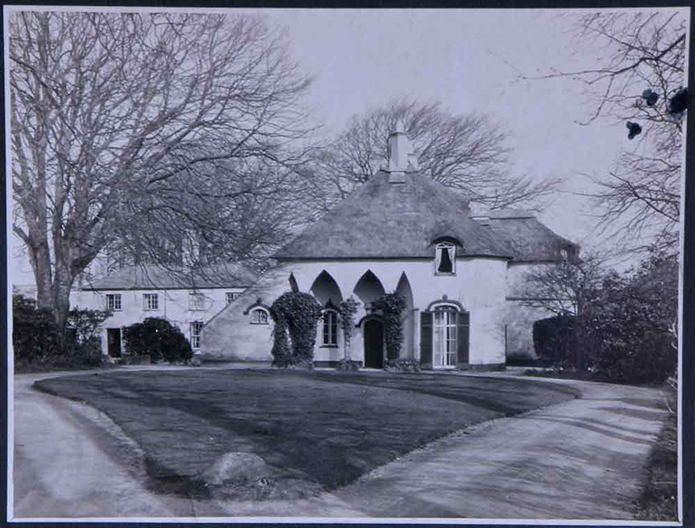
La Patrimoine, St Lawrence. Henry Bosdet died here on 25 May 1934. Image courtesy of Maya Hammarsal.
An article in the Jersey Evening Post on 24 May stated that,
“The deceased, who was a native of Jersey, was famous for his exquisite work, examples of which are to be seen in many of the cathedrals and churches on the mainland (England.) It may indeed be said that he was at the very top of his profession, and for years was on the staff of the Royal Academy where hundreds of pupils passed through his hands.”
Bosdet’s funeral service was at St Saviour’s Church. He joined all his parents and first wife in the family grave.
In summary Bosdet was a prolific master artist who set himself high standards and who, through his work in education, encouraged his students to the same great heights. He regularly held down several teaching jobs while producing countless stained glass windows from his studios. It could be said that Henry Thomas Bosdet was a workaholic. However, I think he was driven less by greed than an overpowering urge to produce great works of art. His pragmatic approach combined, with an astute business head, ensured regular work which provided for his family and gave an outlet for his creative self. What little has been written about him indicates an educated, cultured, quiet man who was loyal to his friends, supportive of his students and generous with his time and skills. Henri Thomas Bosdet remained a proud Jersey man throughout his life. He leaves behind him a legacy of beautiful architectural art that will endure for centuries inspiring generations to come.
References:
The Glass Rainbow – Aidan Smith OBE ISBN 0-9538858-1-X
Bosdet: The Man Behind the Glass Window (2009) Maya Hammarsal and Mark Jones www.bosdetfilm.com Screenings of this film are made regularly at the Jersey Museum, St Helier, Jersey CI.
* After Maya finding the Bosdet painting at St Saviours Church, Sunbury, London, it has been kindly donated by the Church of England to The Jersey Heritage Trust. It has since been restored by the Glass Rainbow Trust and will be on public display in the Island of Jersey.
Maya Hammarsal is a freelance writer and filmmaker originally from Jersey, Channel Islands. She now lives in Wellington, New Zealand. Maya has an interest in preserving the rich culture, traditions and language found in the Channel Islands. Her work often focuses on stories based around Island history.

